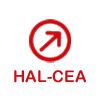New 3D coded aperture collimator for X/gamma-ray wide-field imaging
Résumé
Remote localization of radioactive sources is vital to the nuclear industry and high-energy astrophysics. One widely used method to localize radioactive sources relies on indirect imaging with coded aperture cameras. It involves using a coded aperture collimator called the “coded mask” accompanied by a position-sensitive X/gamma-ray detector with a dedicated deconvolution algorithm. However, a known disadvantage of such cameras is their limited field of view, resulting in a restricted capture area when analyzing complex contaminated scenes or transient astrophysical events.
Our paper introduces a new non-planar coded mask prototype designed to expand the field of view of standard coded aperture cameras. Our 3D coded mask is a tantalum hemisphere with a spiral-shaped hole. We use the Maximum Likelihood Expectation Maximization algorithm to reconstruct the radioactive source images. We test our prototype on data acquired with Timepix3 hybrid pixel detector equipped with our mask.
Mots clés
instrumentation
nuclear instrumentation
ionizing radiation
radioactivity
remote localisation
gamma imaging
gamma camera
coded aperture camera
coded aperture collimator
X-rays
gamma-rays
detector
signal processing
signal deconvolution
non-planar coded mask
field of view
spiral-shaped hole
Maximum Likelihood Expectation Maximization algorithm
Timepix3
Fichier principal
 O_07-193.pdf (3.83 Mo)
Télécharger le fichier
Fichier principal
O_07-193.pdf (3.83 Mo)
Télécharger le fichier
Fichier principal
 Susaiev-2023-08-12-paper-final.pdf (872.61 Ko)
Télécharger le fichier
Susaiev-2023-08-12-paper-final.pdf (872.61 Ko)
Télécharger le fichier
| Origine | Fichiers produits par l'(les) auteur(s) |
|---|
| Origine | Fichiers produits par l'(les) auteur(s) |
|---|


